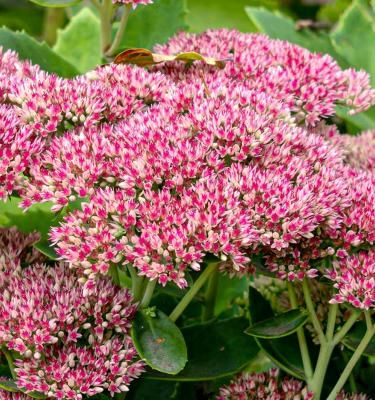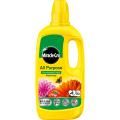

How to grow Sedums
Sedums are well known for their fleshy, thick leaves and stems. They are a type of succulent, meaning that they are able to store water until they need it. This makes them perfect for a dry location, indoors or outside. Plants in the Sedum genus are easy to grow, produce lots of nectar for pollinators, and provide lovely autumn colour.
Types of Sedums to grow
There are two broad types of Sedum. Stonecrop Sedums are ‘true’ Sedum, and are in the Sedum genus. Border sedums used to be part of the Sedum genus, but have been reclassified and are now part of the Hylotelephium genus. These Hylotelephium types of plant are often still labelled and sold as Sedums.
Varieties of border Sedums (Hylotelephium spp.) to consider:
- Hylotelephium ‘Herbstfreude’. Pale green foliage and mid-pink flowers which turn to a burnt orange colour later in the year. ‘Autumn Joy’ is a popular cultivar with large, flat flowerheads that continue to look structurally spectacular even as they turn brown into the cooler months.
- Hylotelephium spectabile. A herbaceous perennial with upright stems reaching 45cm (18") tall, and pink flowers.
- Hylotelephium ‘Sunsparkler’. Reaching just 20cm (8") tall and twice the width, the star-shaped pink flowers appear in the summer and will last through to the autumn.
- Hylotelephium telephium ‘Purple Emperor’. This variety has lots of pink buds which open to white flowers, and foliage which darkens as it matures.
- Hylotelephium telephium ‘Matrona’. Winner of the prestigious RHS Award of Garden Merit, this variety impresses with delicate light pink flowers and grey-green leaves with a purple edge and midrib.
Stonecrops Sedums (Sedum spp.) to consider:
- Sedum acre. Also known as biting stonecrop and gold moss stonecrop. A creeper which is especially good for ground cover, it has star-shaped yellow flowers and likes dry, sandy conditions.
- Sedum album. Known as White stonecrop, owing to its white flowers. This is a low grower which is perfectly suited to the cracks of a wall or in a rockery.
- Sedum kamtschaticum, or orange stonecrop. Golden yellow flowers atop small green leaves. Looks great when used to underplant orange flowered roses.
- Sedum morganianum. Also known as donkey tail (‘Burrito’) and burro’s tail. It has trailing stems, waxy blue-green leaves and dark pink flowers on the tips. It’s great as a houseplant, but is sensitive to cold conditions, so will need protection if growing outdoors. Needs full sun and regular watering.
- Sedum nussbaumerianum, or coppertone stonecrop. Yellow-green foliage which turns to a pretty orange and red when exposed to long periods of full sun.
- Sedum reflexum. A low and fast grower which will typically reach 10cm (4") high. It produces yellow flowers, but the real attractions are the different shades of leaf colours available, including some variegated cultivars. Perfect as a houseplant or in the garden where it can complement other native plants.
- Sedum spurium. A mat-forming and fast growing sedum which can provide leaf colour all year round. ‘Dragon’s blood’ is a spectacular cultivar which produces dark pink flowers.
What you’ll need to grow Sedums
Sedums can be grown in the ground or in a container.
To grow Sedums in the ground, you will need:
- Gloves.
- Spade or trowel.
- Sedum plant.
- Watering can.
To grow Sedums in a pot, you will also need:
- Container.
- Horticultural grit.
- Miracle-Gro® Peat Free Premium Cactus & Bonsai Compost.
Always wear gloves when handling Sedums as they can irritate the skin.
- Whether planting into garden soil or in a container, create a hole which matches the depth and width of the plant roots.
- If you are growing the Sedum in a container, make sure to provide good drainage at the base so that excess water can drain away. Using horticultural grit and Miracle-Gro® Peat Free Premium Cactus & Bonsai Compost will help with this.
- Place the plant in the bottom of the hole, and backfill with soil or compost to ensure good contact between the roots and the growing medium.
- Water the plant well to begin with to ensure that its roots have settled into the soil.
Where to plant your Sedums
All Sedums need well drained soil and to be grown in a light location. They prefer neutral to slightly alkaline soil, and do not tolerate excessive water, so are not suitable for consistently wet conditions.
Border Sedums - also known as ‘ice plants’ - tend to be taller than stonecrop sedums, and are often planted in a garden border. They are relatively low growers compared to many other garden plants, so look best at the front of a border. They work well with plants of contrasting shape, such as ornamental grasses. Border Sedums are usually planted out from April to June.
Stonecrop Sedums are versatile plants, and can thrive inside or outdoors. They can be planted most of the year round. As a houseplant, stonecrops are great in an open terrarium, alongside cacti, where both types of plant have similar growing needs.

A roof covered in stonecrop Sedums is another fun way to attract beneficial insects and bees into the garden. A Sedum roof is great for absorbing noise too, making it perfect for a garden office. Just make sure that the roof is strong enough to take the weight.
You can also use stonecrop sedums for ground cover, where their mat-forming habit can create an unusual lawn effect. For a very dry part of the garden, try planting Sedums alongside other drought-tolerant plants.
Caring and nurturing your Sedums
Both border and stonecrop sedums are low maintenance plants.
Newly planted Sedums must be watered until they have become established. Once they have settled in, it is important not to overwater them - sedums are generally problem free, and challenges only usually occur with excessive moisture.
Most Sedums that we grow love heat and sunny conditions but there are some Sedums that prefer cooler conditions. Check the variety you are growing, as the temperature tolerance varies depending on the species.
For border Sedums, cut back spent flower heads from February to April. New green foliage at the base of the plant should be visible, and should be left in place. Add a layer of mulch around the Sedums, avoiding the new growth. At the end of May, perform the ‘Chelsea chop’ - cut a third to half of the stems to the ground, to discourage the plant from flopping out from the centre. Stonecrops do not need any aftercare other than to water occasionally.
Propagating Sedums
Sedums can be grown from seed, but it is cheaper, quicker and easier to propagate them from existing plants.
Divide border Sedums in the spring. Dig the plant up, and use a sharp knife to separate it into clumps. This can be done every 3-4 years, giving you a steady source of new sedum plants.
Stonecrop Sedums can be lifted from the pot, and any offsets cut away from the main plant using a sharp knife. This is best done in the autumn.
Replant clumps or offsets following our guide above.
Common pests and diseases with Sedums
Sedums are rarely attacked by pests, and diseases only usually arise where moisture levels are too high. Powdery mildew can appear in humid atmospheres. Crown rot and many other fungal diseases also thrive in wet conditions. Oedema is another condition which can appear when a sedum is overwatered.
Avoid all of these problems by providing good drainage and watering in moderation.
Frequently asked questions about Sedums
Do sedums dieback in winter?
The flower heads of perennial border Sedums will die back in the winter, with new growth appearing at the base of the plants in the spring. Stonecrop Sedums grown as houseplants will provide interest throughout the year, as for other indoor plants.
Does sedum come back every year?
Many Sedums are perennials and will come back every year. Some annual and biennial varieties are available, and these will not come back every year.
Is sedum poisonous to dogs?
Sedums are not poisonous to dogs, although any plant eaten in large quantity can cause an upset stomach and vomiting.
How do you grow sedums successfully?
Grow Sedums from cuttings. Plant them into specially formulated compost, water until established and then only minimally.




